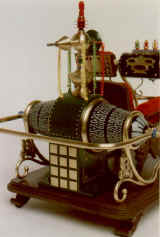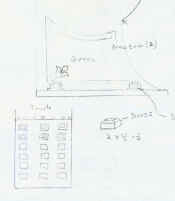Chris
Perrotta has provided me with so many fascinating bits
of information that it seemed about time to gather them together,
here on one page. As Chris wrote me in an email, "This interest
really has a life of its own!"
If
you've seen "The Journey Back," you know the twisted history
of the full-sized prop following the film -- how it was sold at the
MGM auction, how it toured the country in a sideshow; how dilapidated
it became; and Bob Burns' purchase of the machine at a thrift shop
and subsequent restoration.
A
couple of key pieces were missing from the machine when Bob Burns
heroically rescued and restored it, and there have been some differences
of opinion since that time regarding what the machine looked like
as originally created for the film... versus what the machine looks
like today. To most people, the differences would be considered minor
and hardly worth nothing. But as I said earlier, the majority of pages
on this site are not about "most people." They're about
the truly dedicated fans.
I
respect all of the experts... all
of the people who care so passionately about this "interest with
a life of its own." And I am absolutely amazed by the depth of
knowledge, dedication, and attention to detail displayed by Chris
Perrotta.

PERROTTA'S
PLANS



Above:
thumbnails [click to enlarge] left to right --
Chris
Perrotta's Time Machine Blueprint
Chris's
Time Machine chair Blueprint.
Chris's
Blueprint serves as backdrop for a Harvey
Mayo model
Chris
Perrotta: These
are not an artist's rendition of the famed movie prop... but rather
an engineer's dead-accurate drawings created from original archives
and other sources. In fact, the drawings are made up from over 18
MB of AutoCAD files. Every detail is there; every rivet and line accounted
for. You may even find details you didn't know were there; even the
elusive mystery chair has been highly documented! The chair shows
modifications that were made for the movie prop. Interested? Write
to Chris.
His
email is: crisperr(mumla)tx.rr.com
(N.B.: Replace "(mumla)" with an "@", this is
to prevent spam mail)
He
has also a website, www.lockitstraps.com,
where he is selling practical straps for all kind of guitars, called
"lock-it Guitar straps USA". I highly recommend them, alas
I do not play guitar...
Sandra
Petojevic, May 10, 2009

THE
TIME MACHINE'S CHAIR
Chris
Perrotta: The chair
has all the intrigue of a Chinese jigsaw puzzle. I have photos,
very close up, that reveal that the bottom of the chair -- the part
with the seat pad -- originally lifted out, so that a barber could
clean the hair out. Another detail revealed by the photos is the chair's
back, which was hinged very simply to the sides. The backrest, for
the movie modification, had to be pinned or screwed into place to
prevent it from falling backwards... because the prop guys removed
the natural link-up hinge that went to the armrests and then to the
"Swan heads." Once this connection was removed, the back
would have just flopped backwards.
I'm
sure most folks know by now that the original chair's foot
rest became Rod Taylor's head rest!
It
will soon be a link here to a lot of materials about the chair. Check
it out soon!
Sandra Petojevic, May 10, 2009

HOLLOW
CLAIMS
Chris
Perrotta: The
underside of the Time Machine base is hollow and still unpainted!
The entire lamp-stand, except for a two inch section and the 5-1/2"
diameter ball is made almost entirely out of wood! The pegs
around the dish are made from 1/2" diameter by 1/2"
long sawn dowel. These are nailed from the back thru individual painted
Plexiglas sections.

NOT
FOUR ROWS OF THREE, SIX ROWS OF THREE
 LEFT:
As seen on the Granite City Machine (with dish removed)... four rows
of three squares, the 'standard' for all current models.
LEFT:
As seen on the Granite City Machine (with dish removed)... four rows
of three squares, the 'standard' for all current models.
Chris
Perrotta:
I'd like to go into a rather obscure discovery and share it with you
and others via your site. That is: the six, yes, six
rows of rectangular shapes that were originally on the back of the
generator.
Not
four rows of three, as seen on the restoration of the full-size prop,
and as subsequently copied by those who have based their own models
on this Machine... but six rows of three, as seen in the film! These
relatively benign little plant-ons, even though rarely seen, do
have a function. Well... six of them do, anyway.
Do you know what I think they were for?
When
I was laying the whole project out in CAD, working with some drawings
made at the time of the auction, and verified by actual photographs,
it became apparent that the top two rows -- that nobody can ever seem
to see -- lay exactly in the path of the turning pegs on the
dish. Those top two rows, as the notes indicated, were hollow, or
cut-out, to expose the inside of the generator.
No
reason was given. But... the pegs on the turning dish swept pass them
exactly, in close proximity. My guess is that their function
was to remove heat. That's my deduction anyway, because it seems to
me that this goes beyond mere coincidence.
All
the models I've ever seen, large or small, Scottish [Granite City]
or otherwise, get this small, but original, detail wrong.
Yes, you need to be obsessive to appreciate a tidbit like this, I'll
admit. And my speculation about 'heat removal' as the function
of these parts might be right or wrong. But this doesn't change
the fact that there were six rows by
three columns of rectangles (not squares). There's a publicity
still that shows the machine outside on the grass in the bushes
where you can see the back of the machine. If you look at the rear
of the machine under a magnifying glass, you can see the beginning
of the fifth row. And then there's the photo and sketch below.

 LEFT:
1970 MGM auction photo. Just peeking out, below the dish, is a smidgen
of one of the blocks from the fabled 'missing fifth row.'
LEFT:
1970 MGM auction photo. Just peeking out, below the dish, is a smidgen
of one of the blocks from the fabled 'missing fifth row.'
RIGHT: A Sketch made at the 1970 MGM Auction shows six rows,
with the top two rows distinctly different, having been
cut-through.
Chris
Perrotta: I'll admit, the photos and the note are not
of the highest quality, but they prove beyond a shadow of a doubt
that there were more than four rows of decorative plant-ons on the
rear of the generator. The photo clearly shows the beginning of the
fifth row. The hand sketch, which was also made during the time of
the 1970 MGM auction, plainly shows that there were six
rows. Also shown is that the top two rows were distinctly different,
having been cut through. The measurements are present, and they indicate
that the plant-ons were rectangular and not square. Further, the rectangular
shapes have been beveled around the edges. My plans have restored
this seemingly insignificant detail back to the original 1960 configuration.
My goal is simply to eliminate the "generation loss" effect
that keeps occurring when an inaccurate feature is copied down from
one generation of model to another. There are other minor corrections
that have been formalized in the plans that correct for a few other
well-intentioned but inaccurate restorations.
Here
is a link to a page I newly made about the yellow quadrangles on the
rear of the Time Machine. Check it out here!
And
for you all Time Machine lovers, click here
to see a lot of pictures of the Wah Chang miniature model, and - of
course - large detailed images of the Time Machine itself! See and
enjoy the skill of a master computer drawer: Chris Perrotta!
Sandra Petojevic, May 10, 2009
Don Brockway, April 20, 2000 (updated May 16, 2005
and May 10, 2009 by Sandra Petojevic, Master of Arts)
